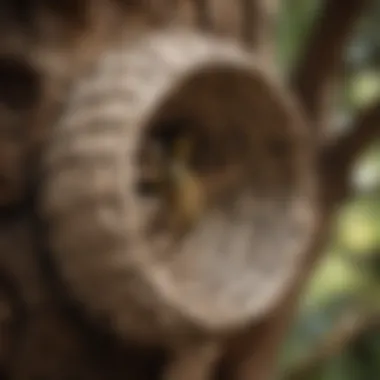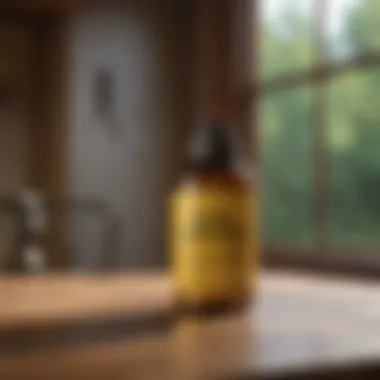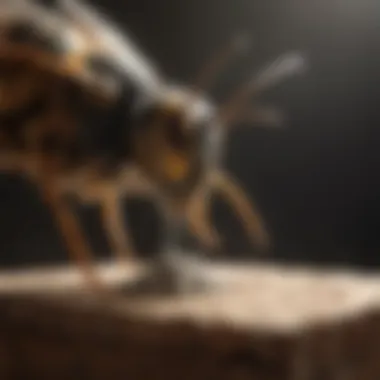Effective Strategies for Eliminating Wasps in the Home


Intro
Wasp infestations can be a significant problem for homeowners. These insects, though crucial to our ecosystem, can pose risks when they invade residential spaces. Understanding their behavior and habits is essential for effective management. This guide aims to provide comprehensive strategies for eliminating wasps from homes while ensuring safety and maintaining a sound living environment.
In this article, we will explore various aspects of wasp management. This includes identification techniques, prevention methods, and removal strategies. Homeowners will benefit from detailed instructions regarding both chemical and natural solutions. Furthermore, we will discuss potential health risks associated with wasp stings and long-term preventative measures to keep areas wasp-free.
By equipping yourself with this knowledge, you can tackle wasp-related issues pragmatically, implementing solutions that safeguard your home and family.
Understanding Wasps
In order to effectively eliminate wasps from your home, first, it is essential to understand the nature of these insects. Knowledge about wasps is crucial because it helps homeowners identify the creatures, recognize their behavior, and perceive potential risks they pose. Wasps can become a nuisance, especially during summer, when they are more active. Learning about their characteristics and habitats is a vital step for effective management.
Types of Wasps Found in Homes
Several species of wasps commonly invade residences. Common types include the yellow jacket, paper wasp, and hornet.
- Yellow Jackets: Often white and black, yellow jackets are aggressive and usually build their nests in the ground or inside wall cavities. Their behavior is territorial, especially when food sources become scarce.
- Paper Wasps: Recognized for their umbrella-shaped nests made from a paper-like substance, these wasps are less aggressive. They typically build their nests under eaves or in sheltered areas.
- Hornets: These large wasps construct distinctive nests that resemble paper lanterns. They can be aggressive and should be approached with caution.
Understanding these types enables homeowners to better prepare for encounters, as each type requires different management techniques.
Life Cycle and Behavior
The life cycle of wasps consists of four stages: egg, larva, pupa, and adult. Female wasps lay eggs in nests that the worker wasps build. As eggs hatch, larvae feed on the food provided by the adults, often consisting of insects and sugary substances.
Wasps exhibit distinct behaviors that vary by species. For example, yellow jackets are attracted to food and waste, making uncovered trash an easy target. In contrast, paper wasps tend to feed on nectar.
Understanding these behaviors helps homeowners anticipate wasp activity and take suitable preventive measures, like securing garbage and removing food sources from outdoor areas.
"Effective prevention requires knowing what attracts wasps to your environment."
By recognizing that each type of wasp has different nesting habits and food preferences, the home can be managed more proactively to reduce and eliminate infestations.
Identifying a Wasp Infestation
Identifying a wasp infestation is a crucial step for homeowners. Early detection can prevent further complications that come with an established colony. Knowing how to recognize signs of wasps can greatly reduce the risks associated with their presence, including painful stings and allergic reactions. Moreover, it helps in planning effective removal strategies and ensures a safer environment for people living in the house.
Wasps usually build their nests in sheltered areas, often near human activity. These places may include attics, eaves, or even underground. Hence, staying vigilant is important. The awareness of where these pests flourish can also aid in taking proactive measures, thus avoiding future infestations.
Signs of a Wasp Nest
Signs of a wasp nest are key indicators for identifying an infestation. The first sign you might notice is an increase in wasp activity around your home. These insects are often seen flying either towards a nest or hovering near food sources. If you spot them consistently, it may signal that you have a nearby nest.
Look for the following signs:
- Visibility of Nests: Wasps build nests that can be grey, tan, or brown. They may appear papery and resemble a small balloon hanging from a branch or the eave of a house.
- Drone Sounds: Often you can hear a buzzing noise when close to a nest. This sound might grow louder as you approach.
- Foraging Behavior: Wasps actively seek food during warmer months. If you notice them around trash bins or areas where food is stored, it indicates they are in the vicinity.
- Aggressive Behavior: If wasps become aggressive towards you or your pets, it suggests you are near their nesting area.
"Noticing warning signs early can significantly ease the removal process and enhance safety."
When you have confirmed these signs, it is essential to take actions immediately. Ignoring these indications might lead to larger infestations, making removal more difficult and risky. By identifying a wasp infestation early, you can utilize the right methods for effective eradication.
Health Risks Associated with Wasps
Understanding the health risks presented by wasps is crucial. These insects pose not just a nuisance but a genuine threat to wellbeing, especially for those with sensitivities. Recognizing how wasps can impact health can help homeowners better prepare for encounters. This section emphasizes the importance of being aware of wasp behavior, potential stings, and the biological impact they may have on different individuals.
Understanding Wasp Stings
Wasp stings can be quite painful and often result in immediate discomfort. The pain usually occurs due to the venom injected during the sting. This venom includes a mix of proteins that affect skin cells and the immune system, leading to swelling and redness. The initial reaction often subsides within a few hours, but the lingering effects can vary. Individuals generally experience different levels of pain and swelling.


In addition to pain, some people may experience systemic symptoms. Nausea, headaches, and fatigue can manifest as the body reacts to the venom. Awareness of these symptoms is essential. Homeowners should be vigilant and prepared for the possibility of being stung.
"The sting of a wasp is not just a local reaction; it can cause wider symptoms for some individuals."
Allergic Reactions and Emergency Response
Allergic reactions to wasp stings can escalate quickly. For many, a sting can lead to intense bodily responses, including anaphylaxis, a life-threatening condition. Symptoms of anaphylaxis may include difficulty breathing, rapid pulse, dizziness, and swelling of the throat. Immediate medical attention is critical for those exhibiting severe reactions.
Homeowners should know the following key points about allergic reactions:
- Identification: Recognize signs of severe reactions immediately.
- Emergency Plan: Keep an emergency kit readily accessible that includes antihistamines or an epinephrine auto-injector.
- Calling for Help: In cases of severe allergic reactions, calling emergency services should be the first action.
Maintaining a level of preparedness can significantly reduce health risks in wasp encounters. The reality of potential health emergencies must be part of the conversation surrounding wasp removal and prevention.
Preparation Before Removal
Before attempting to eliminate wasps from your home, it is essential to prepare adequately. Proper preparation can significantly increase the effectiveness of your removal efforts while also ensuring safety. Ignoring this phase may lead to dangerous situations, such as provoking the wasps and increasing their aggression. Thus, taking the time to assess the environment and having a clear plan is critical.
Assessing the Situation
Begin by observing the area where you suspect wasp presence. Look for nests and frequent wasp activity. It is vital to understand the size of the infestation, as a larger nest may require different strategies compared to smaller ones. Identify the specific type of wasps, if possible, as the approach might vary. For example, yellow jackets typically build nests in the ground, while paper wasps favor sheltered areas.
"Assessing the situation accurately lays the groundwork for a successful removal strategy."
Next, note the general behavior of the wasps. Are they aggressive? Do they appear more active at certain times of day? This information can help you determine the best time to approach the nest for removal. It is advisable to do this during dusk or dawn when wasps are less active.
Necessary Tools and Materials
Having the right tools and materials is essential for a safe and effective removal process. Gather the necessary equipment before you start dealing with the infestation. Here are some basic items you might need:
- Protective Gear: Include long sleeves, gloves, and a face shield. These items protect against potential stings.
- Sprays or Powders: Choose effective wasp-specific insecticides if you plan to use chemical solutions. Ensure you read the labels for instructions.
- Natural Solutions: If you prefer natural remedies, consider options like peppermint oil or dish soap.
- Traps: Commercially available traps can help reduce wasp numbers before active removal.
- Flashlight: This helps when assessing during low light times.
Having these tools ready can help make your removal process safer and more successful.
Methods for Killing Wasps
Effectively eliminating wasps is crucial for maintaining a safe and comfortable home environment. Wasps can pose a significant threat due to their stinging capability and aggressive behavior when provoked. This section will explore various methods for killing wasps, addressing chemical solutions, natural remedies, and traps and baits. Each method has its benefits and considerations, allowing homeowners to make informed choices based on their specific situations and preferences.
Chemical Solutions
Chemical solutions are often the first line of defense for many homeowners dealing with wasp problems. These products typically contain insecticides that are highly effective in eliminating wasps rapidly. Common products may include sprays specifically designed for wasps. When using chemical solutions, it's vital to follow the manufacturer's instructions carefully to ensure safety and effectiveness.
Benefits of using chemical solutions include:
- Quick action: Many insecticides produce immediate results, killing wasps on contact.
- Wide availability: These products are easily found at garden centers and home improvement stores.
- Targeted application: Some chemical sprays are designed to reach nests in elevated places, improving accessibility.
However, there are considerations:
- Health risks: Chemical residues may pose health risks to humans and pets if inhaled or ingested.
- Environmental impact: Some chemicals can harm beneficial insects and overall ecosystem.
To use chemical solutions effectively, it is wise to apply them during the evening or early morning when wasps are less active. Stand at a safe distance and spray directly at the nest or near the wasps to minimize your exposure.
Natural Remedies
For those who prefer a less toxic approach, natural remedies serve as viable options for killing wasps. These methods often utilize substances that either repel or eliminate wasps without harmful effects on the environment. Common natural remedies include solutions made from soap and water, peppermint oil, or vinegar.
Benefits of natural remedies are:
- Eco-friendly: Natural ingredients reduce the risk of harming non-targeted species.
- Safety for humans and pets: Most natural solutions are generally safe for domestic animals and human health when used correctly.
- Cost-effective: Many ingredients may already be available at home, reducing additional costs.


Yet, these remedies may also come with considerations:
- Effectiveness: Some natural methods may not work as quickly or effectively as chemical solutions.
- Inconsistency: Results can vary based on the specific situation and environmental factors.
To create a soap and water solution, mix two tablespoons of dish soap with water in a spray bottle and apply it directly onto wasps or their nests. This method works by suffocating the insects.
Traps and Baits
Utilizing traps and baits offers a strategic approach to killing wasps and controlling their population. These devices can be homemade or purchased from stores. They lure wasps through attractive scents and ultimately capture or kill them.
Benefits of traps and baits include:
- Ongoing control: Traps can reduce the number of wasps in your area over time.
- Minimal risk: When set up correctly, traps reduce the chance of wasps becoming aggressive towards people.
- Versatility: Traps can be placed strategically around the yard or home to capture wasps as they approach.
However, considerations to keep in mind are:
- Limitations: Traps may not eliminate entire nests, especially if the source of the infestation remains.
- Maintenance: Regularly checking and replacing traps is necessary to ensure effectiveness.
For a DIY trap, fill a bottle with sugar water or fruit juice and cut the top opening off, inverting it into the bottle. Wasps will be attracted and unable to escape.
"Understanding different methods to address wasps contributes to a safer living environment and enhances quality of life for homeowners."
Safety Precautions During Removal
Removing wasps from a home can pose serious risks, especially for individuals who are not accustomed to dealing with these insects. Proper safety measures are essential to ensure that the process minimizes potential harm. Homeowners should understand that wasps can be aggressive when threatened, leading to painful stings and even allergic reactions. Therefore, following safety precautions is not merely advisable; it is critical for a successful removal experience.
Protective Clothing
When preparing for wasp removal, wearing appropriate protective clothing is vital. This protective gear acts as a barrier between the individual and the wasps. Recommended gear includes:
- Long-sleeved shirts and pants: These should be made of thick fabric to prevent stings.
- Gloves: Heavy-duty gloves protect the hands from venemous stings.
- Face Protection: A veil or a mask can help protect the face and neck, areas often targeted during an attack.
- Sturdy Footwear: Closed-toe shoes, preferably boots, can provide additional shielding against stings on the feet.
Wearing light-colored clothing is also beneficial, as wasps are often attracted to dark colors. Remaining calm and composed while in this gear will help avoid attracting the wasps' attention, facilitating a more controlled approach to removal.
Timing and Environmental Conditions
Timing is another crucial aspect of safely removing wasps. Wasps are generally less active during certain times of the day, particularly early morning or late evening. It is advisable to conduct removal efforts during these times when the wasps are likely to be dormant.
Additionally, environmental conditions play a significant role. Considerations include:
- Check the Weather: Avoid removal on windy days or during rainy conditions. Wind can disperse sprays unpredictably, and rain can wash away any residual chemicals.
- Avoid Peak Seasons: Wasps are most aggressive during late summer and early fall when their colonies are at their largest. Plan removal efforts in early spring when populations are smaller.
- Assess Surroundings: Ensure that the area around the nest is clear of people and pets. A secure environment can lessen the chance of an unexpected encounter with wasps.
"Preparation is the key to safely eliminating wasps and preventing unwanted incidents during the removal process."
By taking these precautions seriously, homeowners can minimize the risks associated with wasp removal. Ensuring that one is properly equipped and aware of timing can lead to a more effective and safer removal of wasps.
After the Removal Process
After effectively eliminating the wasps from your home, it is crucial to engage in a proper after-removal process. This phase is essential not only to ensure your safety but also to minimize the chance of any future infestations. After all, simply removing the insects does not resolve the underlying issues that may have attracted them in the first place.
Cleaning the Area
Cleaning the area surrounding the nest is one of the primary tasks after removal. This helps to eliminate any scent markers that wasps might leave behind. These markers can potentially attract new wasps to the same location. Here are some important steps to follow during this cleanup:
- Remove debris: Clear away any leftover nesting material, dead wasps, or organic matter that may linger after the removal. This includes checking nearby areas for additional nests.
- Disinfect surfaces: Use a mixture of water and soap to clean the area thoroughly. Vinegar mixed with water can also be effective. Disinfecting wipes or sprays can help ensure that you remove any pheromones that may still be present.
- Check for food sources: Ensure that no food products are easily accessible. Wasps are attracted to sugary substances and protein. Cover garbage bins properly and store food in airtight containers.
- Examine surrounding areas: Check nearby structures, such as sheds or garages, for any signs of new nests or activity.
- Monitor the area: After cleaning, regularly observe the space for any signs of returning wasps. Early detection can prevent larger infestations.
"Cleaning the area not only protects your home but also reinforces the efforts made to eradicate wasps, making it less inviting for newcomers."


Implementing these steps will help solidify the effectiveness of your removal efforts. By maintaining a clean environment and eliminating sources of attraction, you can prevent new wasps from invading your home. Adequate cleaning practices are instrumental in transitioning from an immediate crisis to long-term peace of mind regarding wasp control.
Long-Term Prevention Strategies
Implementing long-term prevention strategies is essential to ensure a sustained wasp-free environment in your home. Taking steps to minimize the risk of future infestations fosters a safer living space and aligns with overall property maintenance. By focusing on both behavioral changes and structural modifications, homeowners can significantly reduce the likelihood of attracting wasps.
Proper Waste Management
Proper waste management plays a vital role in wasp prevention. Wasps are attracted to food sources, and improperly disposed waste can provide a consistent invitation for them. Key practices include:
- Secure Trash Bins: Always use bins with tight-fitting lids. This simple measure limits access to potential food scraps that may attract wasps.
- Regular Disposal: Take out the trash regularly to avoid any build-up of organic waste that emits odors appealing to pests.
- Compost Wisely: If you compost, keep the compost bin well-sealed or placed at a distance from living areas. Avoid placing sweet or protein-rich scraps in compost bins, which can draw insects.
Proper waste management not only prevents wasps but also minimizes other pest issues, contributing to a healthier home environment.
In addition to food waste, be cautious with outdoor dining. Clean up promptly after meals, ensuring that food remnants are not left out, as these attract various insects, including wasps.
Sealing Entry Points
Sealing entry points is another critical strategy in your prevention plan. Wasps often infiltrate homes through gaps and cracks. Regular inspection and maintenance of your property can reduce these vulnerabilities:
- Inspect Walls and Roofs: Look for cracks or holes in the exterior walls, eaves, and around windows and doors. Fill these voids with caulk or high-quality sealant.
- Check Vents and Screens: Ensure vents are screened with fine mesh, preventing entry while allowing airflow. Repair any ripped or missing screens on windows and doors.
- Use Weather Stripping: Install or replace weather stripping around doors to block any gaps. This not only enhances energy efficiency but also deters wasps.
Implementing these strategies encourages a proactive approach to maintaining your home's integrity, ultimately preventing wasps and other pest invaders. Creating an environment that does not attract wasps will go a long way in ensuring your home remains undisturbed.
When to Call Professional Help
Wasp presence can sometimes escalate beyond simple homeowner management. Knowing when to call for professional help is crucial in dealing with what may become a serious issue. Professionals are trained to handle infestations safely and effectively, ensuring minimal risk to your health and property.
Most homeowners can manage minor situations, but certain factors indicate a need for expert assistance. These include the size of the infestation, the location of the nest, and potential health risks associated with wasp stings. If the nest is situated in a high-traffic area, such as near a doorway or children's play area, the risk of stings increases significantly.
Benefits of Seeking Professional Help:
- Expertise: Professionals have the knowledge and skills to identify the type of wasps and their nesting habits.
- Safety: They use specialized equipment and techniques to remove nests with a reduced chance for stings or allergic reactions.
- Long-Term Solutions: Professionals often provide wider management strategies to prevent future infestations.
If any of the following factors are true, consider contacting a professional:
- The nest is large or growing rapidly.
- You have children or pets frequently in the area.
- You are allergic to wasp stings.
- The nest is in a difficult-to-reach area such as under the eaves of your home or close to electrical wires.
"When in doubt, it is wise to seek help from experts who understand the risks involved with wasp removal."
Identifying Severe Infestations
Identifying whether an infestation has reached a severe level requires keen observation. Look out for signs that indicate large colonies may be present. Common indicators include constant activity around a specific area, as multiple wasps gather food or defend the nest.
Key Signs of Severe Infestation:
- Frequent Sightings: If you notice wasps daily, especially in groups, it is likely a sign of a nesting site nearby.
- Enlarged Nest: A visible large nest, whether inside or outside your home, suggests that the colony has become established.
- Aggressive Behavior: Wasps defending their nests will often display a marked level of aggression, especially if people or pets approach.
A well-established nest can host hundreds or even thousands of wasps. If the threat appears to be severe, either because of size or location, professional intervention is advisable to ensure safety during removal.
Closure
The conclusion of this article emphasizes the critical nature of understanding and addressing wasp infestations in a residential setting. Wasps can pose significant health risks, and their presence often disrupts the tranquility of one’s home environment. Thus, eliminating them effectively is not merely about removing a nuisance; it’s about ensuring safety and comfort for all inhabitants.
A key element discussed is the variety of methods available for wasp removal, ranging from chemical solutions to more environmentally friendly natural remedies. Homeowners should understand that choosing the right approach depends on the severity of the infestation and individual preferences towards chemicals in their living space. The article highlighted the importance of preparation and safety measures during the removal process, reinforcing the notion that informed action leads to better outcomes.
Moreover, the emphasis on long-term prevention strategies encourages readers to take proactive steps. Simple actions such as proper waste management and sealing entry points can vastly reduce future infestations. This forward-thinking approach not only saves time and effort but also enhances the overall quality of life at home.
In sum, awareness of wasp behavior, identification techniques, and the implications of infestations allows homeowners to navigate this challenge with confidence. The insights provided throughout the article serve as a comprehensive framework, equipping homeowners with the knowledge needed to protect their homes from these unwanted guests, ensuring a safer living environment.
Recap of Key Points
- Understanding Wasps: Familiarity with different types and their behavior aids in recognizing potential infestations early.
- Identifying Infestation: Knowing the signs of a wasp nest is essential for prompt action.
- Health Risks: Awareness of possible allergic reactions and the correct response is vital for safety.
- Preparation: Assessing the situation and gathering necessary tools ensures a smoother removal process.
- Methods of Removal: Options vary between chemical and natural methods, each with distinct advantages and considerations.
- Safety Precautions: Important to wear protective clothing and choose the optimal timing for removal.
- Post-Removal Care: Cleaning the area prevents attracting new wasps and encourages a pest-free environment.
- Long-Term Strategies: Implementing waste management and sealing points of entry decreases the likelihood of future infestations.
- Professional Help: In cases of severe infestation, recognizing when to seek expert assistance is crucial.
The amalgamation of these points creates a solid foundation for effectively managing wasp issues, ensuring peace of mind in one’s household.



